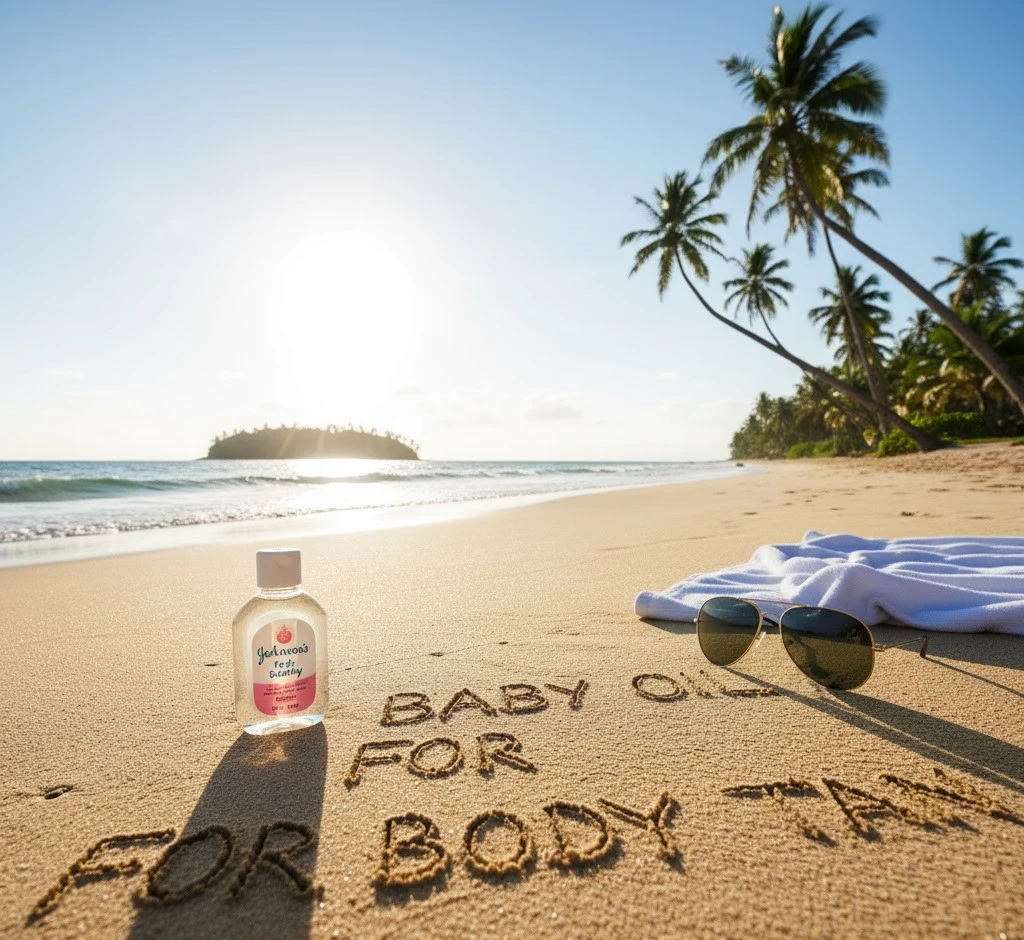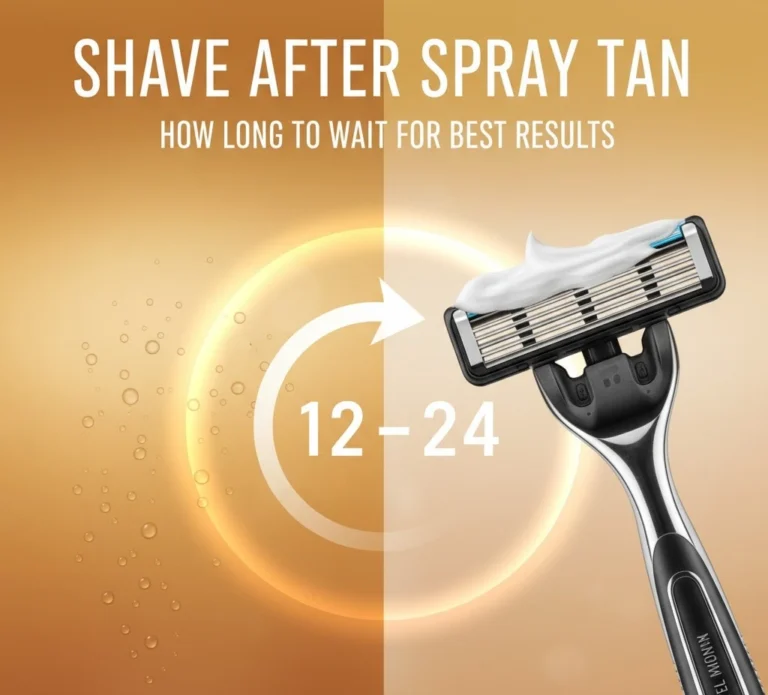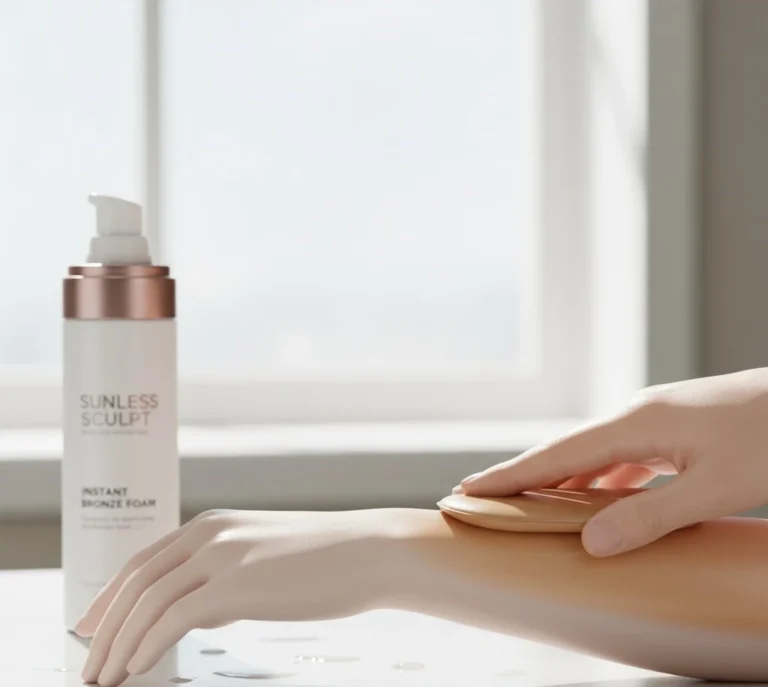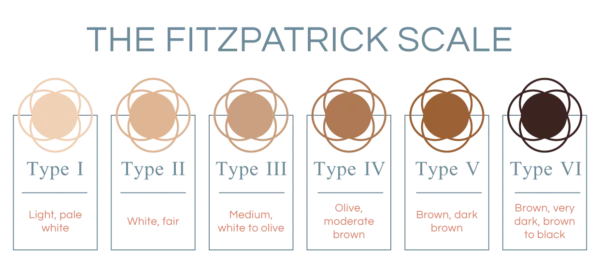What is Baby Oil & Does Baby Oil Help You Tan?
You’ve likely seen a bottle of baby oil in your home. Many people believe that applying baby oil before sunbathing helps you tan faster and deeper. The key question is: does baby oil help you tan? To answer that, we must understand what baby oil is, how tanning works, and whether the common belief holds up against scientific and dermatological evidence.
Table of Contents
What Is Baby Oil Made Of?
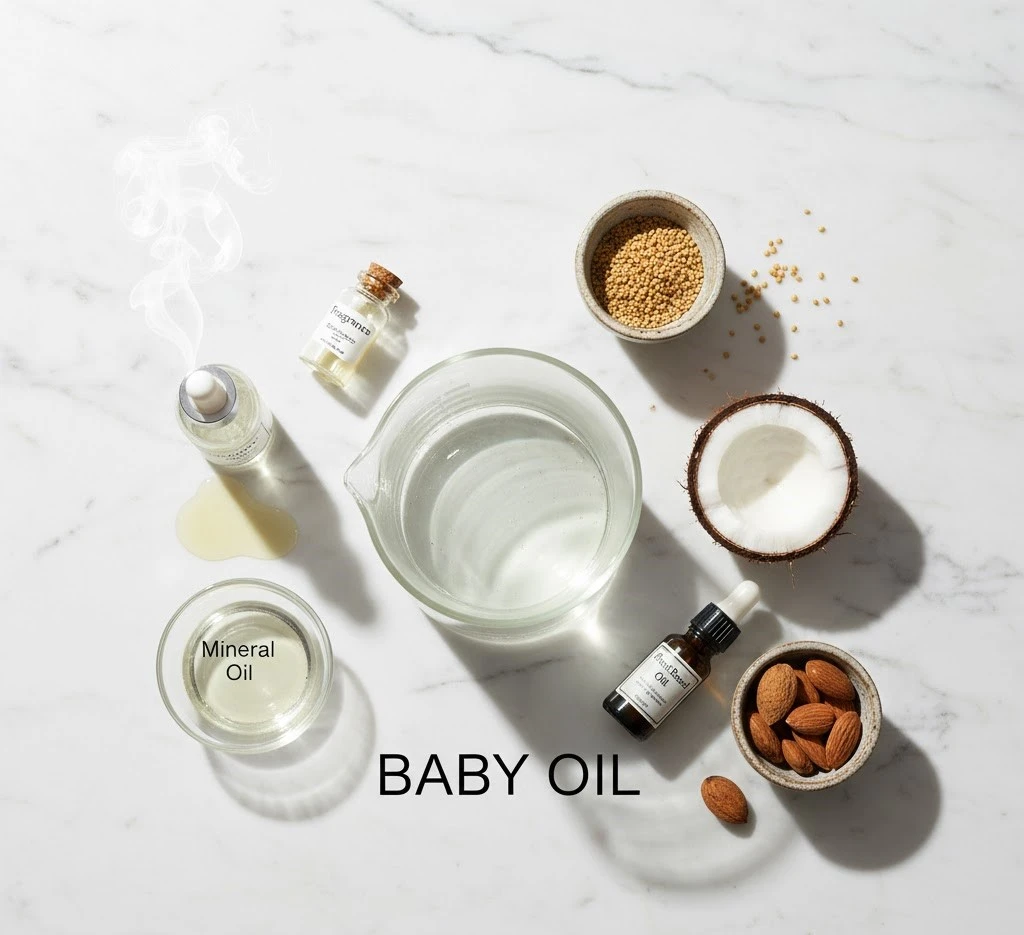
The term “baby oil” refers to an oil-based product designed for skin care, originally made for infants but often used by adults for various purposes.
Ingredients & composition
- The primary component of most baby oils is mineral oil, also labelled as Paraffinum Liquidum or Liquid Paraffin. According to ingredient breakdowns, cosmetic grade mineral oil is a highly refined mixture of saturated hydrocarbons (chain lengths C15-C50) that sits on top of the skin to lock in moisture.
- Many formulations add a small percentage of fragrance (less than 1 %) for scent.
- Some baby oils include emollients and moisturizing additives to enhance skin softness. For example, brands note: “locks in up to 10× more moisture on wet skin than an ordinary lotion” for baby skin.
- The liquid is typically clear, colourless and odor-free (before fragrance). As Wikipedia notes: “Baby oil is an inert oil used to keep skin soft and supple.”
Purpose and design
- The design goal of baby oil is to moisturize skin: by forming a barrier on the surface, it reduces transepidermal water loss (skin drying).
- It is not made with sun‐protection in mind. It does not include SPF or filters that block or absorb UV rays (unless explicitly formulated that way).
- The product is intended for topical use after bathing or for adult skin care; its use for tanning is a repurposing rather than its intended application.
In short: baby oil = mineral oil + fragrance + moisturizer purpose. It works well to make skin feel soft and smooth. But its design does not include UV protection or safe tanning.
Why People Use Baby Oil for Tanning
People use baby oil for tanning for several reasons rooted in belief and cosmetic effect.
Common belief: faster, darker tan
- Many believe that applying baby oil before sun exposure helps the skin tan faster. For example, some say baby oil “helps you to tan” because it increases absorption of UV rays.
- The logic: oil on skin creates a slick surface that reflects and intensifies sunlight, allowing more UV to reach the skin and thus accelerate tanning. Some dermatologists confirm that baby oil “helps attract and absorb UV rays”.
- The result: you may see quicker colour change (tanning) than using no oil.
Perceived benefits
- Smooth glide and shine: Baby oil gives skin a glossier, smoother appearance which many associate with a “good tan” look.
- Cost and accessibility: Baby oil is inexpensive and widely available, making it an easy go-to for sunbathers who want to speed up tanning.
- Trend and nostalgia: The use of baby oil for tanning has been part of beach culture for decades, especially when formal tanning oils or modern sun protection were not as advanced.
Use in social/beauty culture
- People applying baby oil before sunbathing is a classic image of sun culture.
- The belief that “oil = deeper tan” continues to circulate, especially via social media and influencer content.
- This use is less about safe skin care and more about achieving an aesthetic tan quickly.
So yes, baby oil is used by many with the intention of speeding tanning. The next section explains how tanning actually happens so you can judge whether the belief is scientifically valid.
The Popularity of Baby Oil in Sunbathing Culture
The use of baby oil to aid tanning has a cultural and historical dimension.
- In the mid-20th century, especially in the United States, the combination of baby oil and iodine became a popular makeshift tanning oil in warm climates.
- Tanning culture treated a deep golden tan as a symbol of health, leisure and attractiveness. That drove many to use oils like baby oil to boost their tanning speed.
- Even now, social media trends revive old techniques (oil + sun) despite their risks. For example a TikTok trend using baby oil + iodine was noted recently.
- The glossy, shiny look that baby oil gives under sunlight adds to its popularity. The oil layer reflects light and makes the skin appear smoother and more luminous—even if the underlying skin damage is increased.
In short: baby oil’s popularity in sunbathing culture is rooted in aesthetics, quick tanning desire and old habits. But the cultural trend does not mean safe or recommended.
Understanding How Tanning Works
To evaluate whether baby oil helps you tan, you must understand how tanning works: the role of UV rays, melanin production, and what happens when skin is exposed without protection.
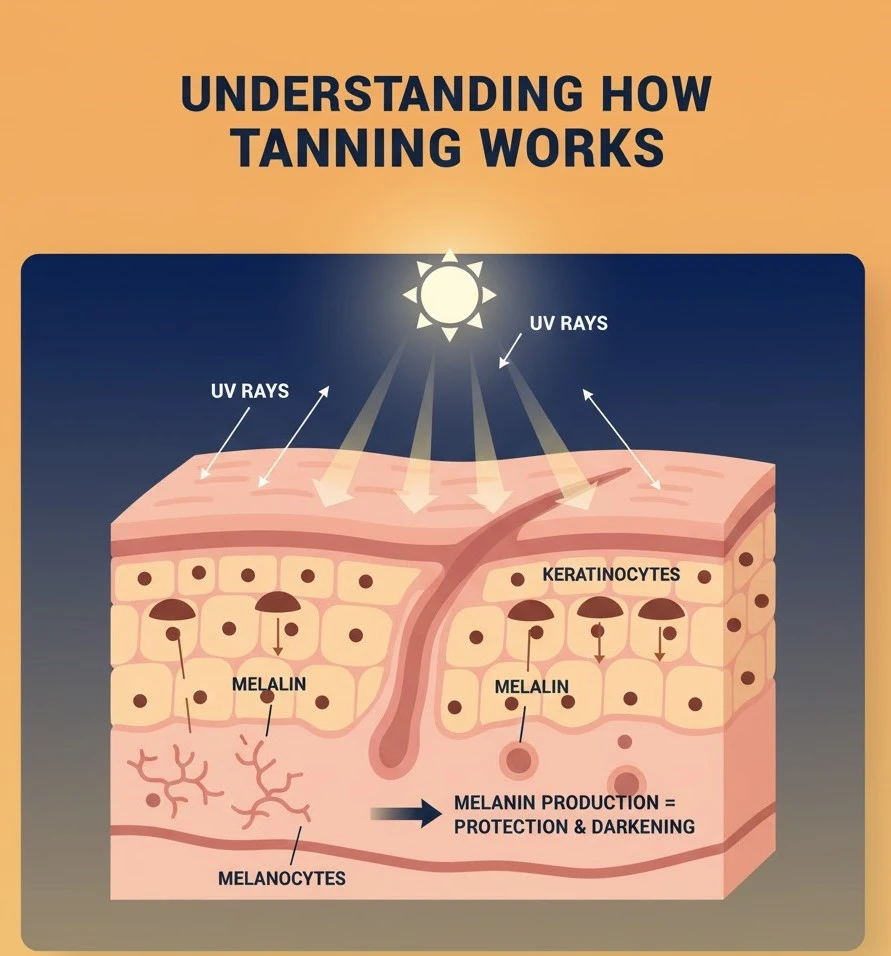
Sunlight includes ultraviolet (UV) rays. Two key types for tanning and skin damage are UVA (wavelength ~320-400 nm) and UVB (~280-320 nm).
UVA rays penetrate deeper into the skin (dermal layers) and contribute to skin ageing, pigment darkening and long-term damage. UVB rays are more likely to cause sunburn and direct DNA damage.
Both UVA and UVB can trigger tanning but via slightly different mechanisms and with different risks.
Important: increased UV exposure = increased risk of skin cancer. The Canadian Cancer Society states: “Exposure to UV rays raises your risk of developing both melanoma and non-melanoma skin cancers.”
How the Skin Produces Melanin
When UV radiation hits the skin’s epidermis, it triggers melanocytes (cells in the basal layer) to produce melanin, the natural pigment responsible for skin colouration.
The tanning process can involve:
- Oxidation of existing melanin (mainly from UVA) which causes immediate darkening but offers little protection.
- New melanin synthesis triggered by UVB and subsequent transfer of pigment to surrounding cells—a “delayed tan” effect that may last weeks.
The tan is your skin’s protective response to UV damage: it tries to shield by increasing pigment, but this protection is modest (≈ SPF 3 at best) and far under recommended sun protection.
What Happens When You Tan Without Sunscreen
Exposing your skin to UV without protection increases risk of sunburn, DNA damage and skin ageing.
A tan itself is not a sign of healthy skin; it is an indicator that skin has been damaged and is responding.
When you apply no sunscreen (or ineffective protection) and expose skin with oil or reflective surface, you accelerate UV penetration, increasing deeper damage.
Regular uncontrolled sun exposure leads to cumulative damage: wrinkles, age spots, skin sagging, and significantly increased risk of skin cancer.
Understanding this mechanism helps evaluate whether baby oil’s effect (if any) is beneficial or harmful. The next section addresses that..
Can Baby Oil Really Help You Tan Faster?
You might think: baby oil makes the skin slick and maybe allows better sun exposure. But what do the facts say?
How Baby Oil Affects Sun Exposure
Because baby oil sits on the skin surface and has no substantial UV filters, the oil layer does not block UV rays. In fact, it may allow increased UV absorption and deeper penetration.
The slick, shiny layer may reflect visible light for cosmetic effect, but it also can raise skin temperature and enhance UV effect by reducing superficial scattering and potentially increasing absorption. Some sources state baby oil “attracts more UV rays” and “allows them to penetrate more deeply”
So yes: baby oil may help you tan faster in the sense of faster colour change—but it does so by enhancing UV exposure rather than by safe tanning.
Expert Opinions on Using Baby Oil for Tanning
Dermatologists are very clear: using baby oil for tanning is unsafe. Key points:
- According to Byrdie: “Baby oil … provides absolutely no protection from damaging UV rays.”
- Dermatologists state there is no safe way to tan — even when using sunscreen. Using baby oil “significantly increases your chances of premature skin aging and life-threatening skin cancers.”
The Science Behind the “Oil Effect” - Oils reduce surface scattering of light and may allow more UV rays to reach lower layers of epidermis.
- The oil may also keep the skin surface more hydrated or reflective, which might superficially enhance tanning appearance. But this is cosmetic rather than safe enhancement.
- However, none of this provides beneficial protection or deeper melanin regulation in a safe manner. The oil simply enables more UV to reach the skin.
- Experts caution that any product that increases UV absorption without protection increases risk of damage.
Expert Opinions on Using Baby Oil for Tanning
- Dermatologists and skincare specialists uniformly discourage using baby oil for tanning. For example: “Baby oil should never be used for tanning” because it increases the risk of burning, deeper UVA penetration, and skin cancer.
- One quote: “People using baby oil may inadvertently burn faster and more easily before realizing they’ve suffered a sunburn… with more sun ray absorption and deeper penetration … your risk of skin cancer may increase as well.”
- In other words: yes, you can tan faster with baby oil—but you also damage your skin faster and increase risk.
So the direct answer to “Does baby oil help you tan?” is: Yes, it helps you tan faster, but it does not help you tan safely.
| Product | Tanning Speed | SPF Protection | Skin Safety | Expert Verdict |
| Baby Oil | Fast but uneven | None | Risk of burns & aging | Not recommended |
| Tanning Oil with SPF | Moderate | Low to medium | Safer than baby oil | Use with caution |
| Sunscreen (SPF 30+) | Slow, gradual tan | Strong | Best for skin health | Highly recommended |
The Risks of Using Baby Oil for Tanning
Using baby oil for tanning carries serious risks. Because the oil increases UV exposure without protection, your skin is vulnerable to multiple types of damage.
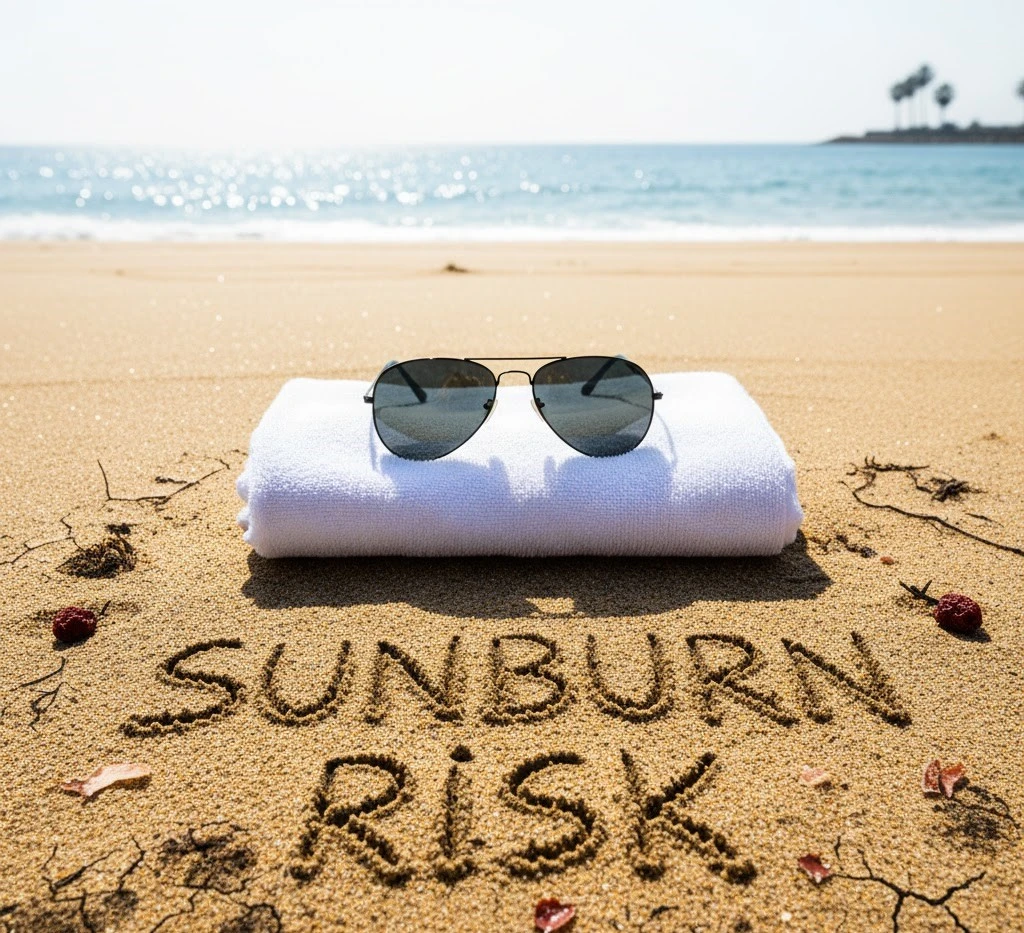
Increased Risk of Sunburn and Skin Damage
Baby oil offers no sun protection factor (SPF). It neither blocks nor significantly filters UV rays. If you apply it before sun exposure, you are essentially allowing UV rays to hit unprotected skin more effectively.
According to dermatologists, tanning oils (and baby oil effectively behaves as one) attract more UV rays and increase skin penetration, making sunburn and damage more likely.
The downstream effects include UV-induced erythema (sunburn), acute damage to skin cells, and enhanced chance of peeling, patchy tan, burns, and immediate discomfort.
Long-Term Effects on Skin Health
Radiation from UV exposure accumulates over time. The Skin Cancer Foundation emphasizes that excess UV exposure is a major risk for skin cancers including melanoma, basal cell carcinoma and squamous cell carcinoma.
Patients who used baby oil or iodine for tanning historically show higher rates of skin cancers, wrinkles and sunspots compared to those who protected their skin.
Additional risks include:
- Premature aging (photo‐aging) – wrinkles, sagging skin, dark spots.
- Uneven pigmentation, patchy skin, and long-term barrier damage.
A tan is not protective enough: the “base tan” myth is false. A tan corresponds to ~SPF 3, which is far below recommended SPF 30+
Common Misconceptions About “Natural” Tanning Oils
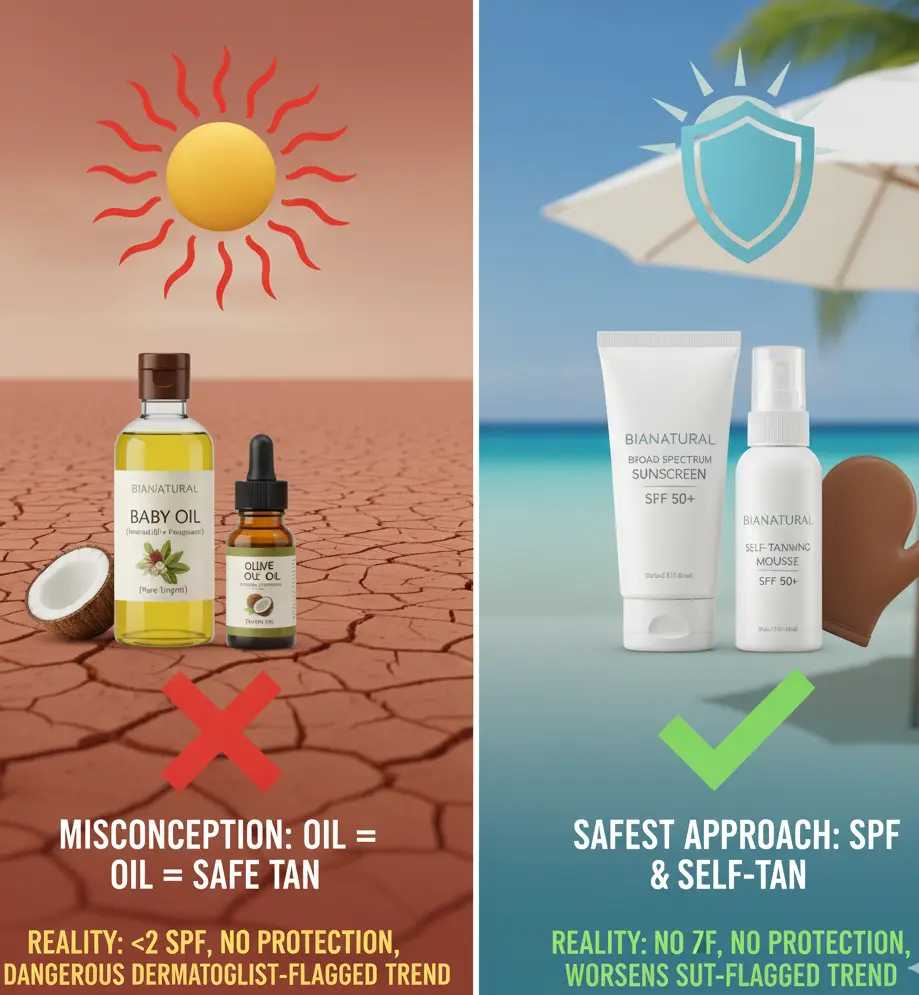
Some people assume that because baby oil seems “natural” or just moisturising, it is safe for sun exposure. That is incorrect.
“Natural” oils or light oils do not equal sun protection or safe absorption. Even “tan-accelerating” oils lack meaningful UV filters.
Another misconception: “If I apply sunscreen then baby oil on top, I’ll be safe.” No, layering baby oil over sunscreen does not guarantee protection and may reduce effectiveness.
In short: Using baby oil to tan does increase risk substantially. The “help you tan” part comes at a cost to your skin health.
Safer Alternatives to Baby Oil for Tanning
If achieving a tan is your goal, you have safer and smarter options than using baby oil. Here are alternatives that reduce risk.
Use Sunscreen with Bronzing or Tanning Features
Choose a broad-spectrum sunscreen with SPF 30 or higher, reapply every 2 hours, and use proper amount (about a shot glass full for full body).
Some sunscreens have bronzing tints or “gradual tan” effects built in. These allow skin to gain colour gradually under safe UV exposure.
Do not assume a tanning oil or baby oil offers protection; always use a true sunscreen.
Consider Self-Tanners or Tanning Lotions
Products containing DHA (dihydroxyacetone) chemically darken the outer layer of skin without UV exposure.
Self-tanners mimic the look of a tan without the UV damage. Experts call this the only safe way to tan.
Tip: Exfoliate skin before applying, apply evenly, then use a body moisturizer for smoothness.
Use Natural Oils with Mild SPF Benefits
While no oil fully replaces sunscreen, some oils offer mild natural SPF or antioxidant benefits and better safety margin than baby oil for casual sun exposure. Examples include coconut oil, carrot seed oil, raspberry seed oil.
Even then, you must pair oil with sunscreen and limit sun time—they are not sufficient on their own.
Important: “Natural” does not mean “safe for unlimited sun”.
Tips for Safe and Healthy Tanning
If you choose to tan (knowing the risks), you can follow safer practices to minimise damage.

Limit Direct Sun Exposure
- Avoid sun exposure during peak UV hours (typically 10 a.m. to 4 p.m.).
- Use shade, wide-brim hat, UV-protective clothing when possible.
- Limit continuous sunbathing sessions; shorter, frequent breaks are safer than long exposures.
Always Stay Hydrated and Moisturised
- Hydrate well before, during and after sun exposure. Dehydrated skin is more vulnerable.
- Apply a good body moisturizer after sun exposure to help skin recover.
- Use a broad-spectrum SPF sunscreen before exposure and reapply after swimming or sweating.
Incorporate After-Sun Care
- After sun exposure, use a soothing after-sun product. Aloe vera, cooling gels, fragrance-free lotions help reduce inflammation and heal skin.
- Monitor your skin for any new spots, colour changes, or burns and consult a dermatologist if concerned.
| Oil Type | SPF Protection | Moisturizing Power | Tanning Speed | Skin Safety | Best For |
| Baby Oil | None | High | Fast (but risky) | Low – can cause burns | Quick dark tan (unsafe) |
| Coconut Oil | Mild (SPF 4–5) | Excellent | Moderate | Gentle on skin | Deep hydration & glow |
| Carrot Seed Oil | Medium (SPF 15–20) | Good | Moderate | Safer option | Natural bronzing effect |
| Raspberry Seed Oil | High (SPF 25–30) | Great | Slow but even | Very safe | Gradual, healthy tan |
Conclusion – Should You Use Baby Oil to Tan?
After reviewing all the evidence, here’s the answer: No, you should not use baby oil to tan. Here’s why:
- Yes, baby oil can help you tan faster, because it allows more UV radiation to reach your skin.
- But that faster tan comes with no protection, higher risk of sunburn, deeper UV damage, premature ageing and increased skin cancer risk.
- A tan is not a sign of healthy skin—it’s a sign of damage.
- You have safer alternatives: sunscreen + gradual tanning, self-tanners, mild oils with protection.
- The desire for a tan does not override your skin’s health and long-term well-being.
So, if you are wondering “Does baby oil help you tan?”, the factual answer is yes—but the follow-up question should be “Is it safe to do so?”, and in that case the answer is no. Protect your skin rather than risking it for a quick tan.
FAQ’s
1 Does baby oil offer sun protection?
No. Baby oil does not provide meaningful SPF or broad-spectrum UV protection.
2 Can baby oil make my skin tan darker than if I do not use oil?
Yes, it may accelerate tanning by increasing UV absorption—but that also increases damage.
3 Is a tan from baby oil safer than a tan without oil?
No. The oil may increase UV penetration and risk, making it less safe.
4 What is the safest way to get a tan look?
Use a self-tanner (DHA-based) or use sunscreen + gradual exposure rather than tanning oils.
5 Does a “base tan” protect you from sunburn?
No. A tan offers very limited protection (approx. SPF 3) and does not replace sunscreen.

